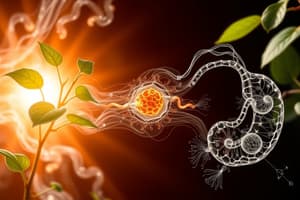Podcast
Questions and Answers
What is the primary function of photosynthesis in plants?
What is the primary function of photosynthesis in plants?
- To synthesize organic compounds from sunlight (correct)
- To absorb water from the soil
- To produce energy for movement
- To regulate plant temperature
Where does the light-dependent reaction of photosynthesis take place?
Where does the light-dependent reaction of photosynthesis take place?
- Thylakoid membranes (correct)
- Cell walls
- Stomata
- Chloroplasts
What is the byproduct of the light-independent reaction of photosynthesis?
What is the byproduct of the light-independent reaction of photosynthesis?
- Oxygen and glucose (correct)
- Carbon dioxide and NADPH
- Water and ATP
- Glucose and ATP
What is the term for the ability of plants to convert light energy into chemical energy?
What is the term for the ability of plants to convert light energy into chemical energy?
Which molecule is the energy-rich product of the light-dependent reaction of photosynthesis?
Which molecule is the energy-rich product of the light-dependent reaction of photosynthesis?
What is the energy source that drives the process of photosynthesis?
What is the energy source that drives the process of photosynthesis?
Which molecule is the reactant that provides the carbon atoms for glucose production during photosynthesis?
Which molecule is the reactant that provides the carbon atoms for glucose production during photosynthesis?
What is the main purpose of the electron transport chain in photosynthesis?
What is the main purpose of the electron transport chain in photosynthesis?
Which stage of photosynthesis does not require light energy?
Which stage of photosynthesis does not require light energy?
What is the byproduct of the light-dependent reaction that is used in the light-independent reaction?
What is the byproduct of the light-dependent reaction that is used in the light-independent reaction?
Study Notes
Photosynthesis Overview
- Photosynthesis is the process by which plants, algae, and some bacteria convert light energy from the sun into chemical energy in the form of organic compounds, such as glucose.
Importance of Photosynthesis
- Photosynthesis is essential for life on Earth, as it provides energy and organic compounds for the food chain.
- Without photosynthesis, there would be no plants, and therefore, no food for animals.
Where Photosynthesis Takes Place
- Photosynthesis occurs in specialized organelles called chloroplasts, which are found in plant cells.
- Chloroplasts contain the pigment chlorophyll, which absorbs light energy and plays a crucial role in the photosynthetic process.
Photosynthesis Equation
- The overall equation for photosynthesis is: 6 CO2 + 6 H2O + light energy → C6H12O6 (glucose) + 6 O2
- This equation indicates that photosynthesis uses carbon dioxide, water, and light energy to produce glucose and oxygen.
Energy Conversion
- Photosynthesis involves the conversion of light energy into chemical energy, which is stored in the bonds of glucose molecules.
- This energy is later used by the plant to fuel its metabolic processes, such as growth and development.
Types of Photosynthesis
- There are two types of photosynthesis: oxygenic and anoxygenic photosynthesis.
- Oxygenic photosynthesis, which occurs in plants and cyanobacteria, produces oxygen as a byproduct, while anoxygenic photosynthesis, which occurs in some bacteria, does not produce oxygen.
Photosynthesis Overview
- Photosynthesis is the process by which plants, algae, and some bacteria convert light energy from the sun into chemical energy in the form of organic compounds, such as glucose.
- This process is essential for life on Earth, as it provides energy and organic compounds for the food chain.
Importance of Photosynthesis
- Produces oxygen as a byproduct, which is necessary for cellular respiration in most living organisms.
- Supports almost all life on Earth, directly or indirectly, as the primary source of energy and organic compounds.
Equation for Photosynthesis
- 6 CO2 + 6 H2O + light energy → C6H12O6 (glucose) + 6 O2
Reactants and Products
- Reactants: carbon dioxide (CO2), water (H2O), and light energy.
- Products: glucose (C6H12O6) and oxygen (O2).
Where Photosynthesis Takes Place
- Occurs in specialized organelles called chloroplasts, which are present in plant cells.
- Chloroplasts contain pigments such as chlorophyll, which absorbs light energy and plays a central role in photosynthesis.
Energy Conversion
- Light energy from the sun is converted into chemical energy in the form of ATP and NADPH.
- ATP and NADPH are then used to power the conversion of CO2 and H2O into glucose and O2.
Studying That Suits You
Use AI to generate personalized quizzes and flashcards to suit your learning preferences.
Description
Learn about the process of photosynthesis, how it occurs in plants, and its importance in the ecosystem. Explore the AP Biology curriculum on Khan Academy.




